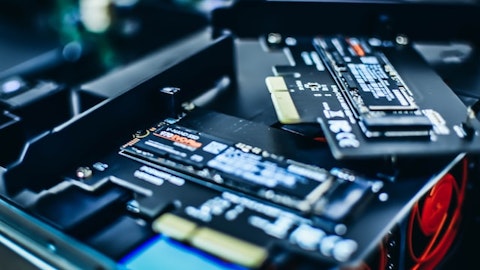Those steps are not there. They need to be built. Yes.So, I think this is something people underestimate how significant the demand in the mid-critical and the mature semiconductor space is, and it will just grow double-digit whether it’s automotive, whether it’s the energy transition, whether it’s just the entire industrial and products area, whether it’s the — whether those are the sensors that we actually need as an integral component of the AI systems.This is where the mid-critical and the mature semiconductor space is very important and needs to grow and this is where China is very strong, and this is why — yes, that could be 40% to 50% of our Deep UV backlog, that’s what it is.Francois-Xavier Bouvignies Thank you very much, Peter. Yes.Peter Wennink Thanks.Francois-Xavier Bouvignies Very clear.Operator Thank you.
We will now go to our next question. And your next question comes from the line of Amit Harchandani from Citi. Please go ahead. Your line is open.Amit Harchandani Thank you. And hello, everyone. Amit Harchandani from Citi. Two questions, if I may. My first question is with regards to the logic end market. You’ve talked about some moderation there, could you give us a sense for — if anything that has changed in terms of discussions with customers. You talk about them sticking to their tech roadmaps, but do you see that as being uniform across customers, do you see any variations, so just a sense of, if you’ve seen anything changed with respect to the logic end market?And my second question is with regards to capital allocation. I believe in the annual report, towards the end of the annual report, you’ve talked about your CapEx for this year being potentially €2.4 billion, which would imply a capital intensity or a level that’s higher than in the past, certainly highest in the last 10, 15 years that I can remember.
Could you give us a sense for whether that’s the one-offs? And how should we think about capital intensity and broader capital allocation out this year and beyond? Thank you.Peter Wennink Roger will take the second question. On the first question, what do we see in change of in the logic end markets, what do we see in terms of change in roadmaps and, I would say, the least change we see in the advanced roadmaps, I mean, it’s very clear that whether it’s the three or the two or the sub-2 nanometer roadmaps those are very clearly defined. There was only two or three players, actually three players that are actually looking into this and I don’t think those roadmaps are changing. I think, the pretty much the push that we get from the customers in that space is to keep our promises in terms of the shipment of the next generation a little to meet their roadmap introduction requirements.
I don’t see that’s a major change there.But I do see a change in respect to the previous question, I do see a change in the roadmaps for the mid-critical and the mature systems. That is — this is where I see customers that are in that space moving from mature to mid-critical from low-mid-critical to high-mid-critical, there you clearly see an acceleration of roadmaps, so it’s more in the mature space, in mature and the mid-critical space than it is in the advanced space and that is also driven by the things I just said. It’s — the whole EUV transition is going to require a significant step up in, let’s say, 20, 28 and 45 nanometer capability and that is where it’s a big opportunity, so you’ll also see roadmaps addressing that opportunity and that’s why we see, in the logic space, it’s the biggest change.Roger Dassen Amit with regard to your second question, the — indeed, the €2.4 billion number that you referred to for the full year, that’s very much in line with about €0.6 billion that you would see for this quarter, so that’s very much in line.
What is in there? Well, obviously, what was in there first and foremost is two things. It’s the preparation for High-NA and it’s the ongoing activities to increase our capacity to the 90 and the 600.On High-NA, part of what is in there is prototypes that we’re building, so we’re building prototypes for High-NA. At a certain point in time, those prototypes will obviously also find their way or part of those prototypes will find their way into the market. So, at a certain point in time, there will be a bit of reversal in there, so that’s part of the year, fairly high number that you see in there. But other than that, there is a lot of construction work going on around the globe in order to accommodate the capacity expansion that we’ve talked about.If you ask about, what do you think in terms of the longer term, I think it is prudent to expect that for the years through 2025, I think, it’s prudent to expect something between, I would say, €1.5 billion, €2 billion, in that neighborhood, I think, it is prudent to assume that we’re going to see these levels of CapEx, because those will be the years where we continue to build the capacity that we have talked about before.Amit Harchandani Thank you, gentlemen.Operator Thank you.
We will now go to our next question. And the next question comes from the line of Aleksander Peterc from Societe Generale. Please go ahead. Your line is open.Aleksander Peterc Yes. Good afternoon, and thanks for taking my question. My first question will be more short term. Just on the systems mix into the second quarter versus the first quarter, so you had a quite a high level of EUV in the first quarter in terms of recognition, I mean, that is specifically — do you expect a similar mix to prevail in the second quarter and then maybe reverse to more Deep UV in the second half or how should we think about? So, I have a quick follow-up as well. Thank you.Roger Dassen I think, you’re right. I think, EUV was slightly over-represented in the first quarter.
So, we’ve always talked about around 60 shipments for the year, so 17 is relatively higher than what you expect. So, I think, it is realistic to assume that in the three quarters to come that number will be slightly lower than the 17 that we have in revenue for Q1.Aleksander Peterc Thanks. And then the follow-up would be just on your higher gross cash requirements in the current environment or is that perhaps due to higher working capital requirements. Could you maybe quantify what is the level of gross cash you will be comfortable in in the current environment? For the time being that I assume is higher than the €2.5 billion you previously mentioned or, in other words, if you could put a number on the higher working capital is required given the optimization of cash flow across the chain?
Thanks.Roger Dassen Yes. I mentioned two dynamics. One dynamic I mentioned is that everyone in the entire value chain is managing their cash flow levels and obviously that means that also our free cash flow might be a little bit under pressure. So, that’s one dynamic. And then, indeed, the second dynamic that we talked about is that we believe it is appropriate in the current environment to sustain or to maintain higher levels of cash.What do I think is realistic? I think, if you look at the cash level at the end of this quarter, if you look at the cash level that we had at the end of the previous quarter, I would say that — those cash levels are definitely sufficient to weather any uncertainties that might be there. So, I think, those cash levels, I think, are more than sufficient to have the flexibility that we’re looking for, more than sufficient.Aleksander Peterc Thank you.Operator Thank you.
We’ll now go to the next question. And your next question comes from the line of Alexander Duval from Goldman Sachs. Please go ahead. Your line is open.Alexander Duval Yes. Hi, everyone. Thanks very much for the questions. I think you talked about mid-single-digit growth in services revenue this year and that’s obviously understandable given hard comps last year, but I wondered if you could give your thoughts on the extent to which there could be upside given low machine utilization that you referenced and that typically in the past from memory has led to higher upgrade activity?And, secondly, a question we’ve received from investors is just on average selling prices, you obviously talked about some weakening semi fundamentals, which you’ve characterized as being shorter term in nature, but just curious to what degree that could limit your ability to increase the ASPs and offset some of those cost pressures you’ve talked about in recent quarters?
Many thanks.Peter Wennink Yes. The upside on service, it’s a good point. I mean, what you generally see is, that while the — if there is an upturn, of course, we don’t get the sufficient time to take down the machine and then do the upgrade and — no, software upgrades are of course easier, but any prolonged down of a machine in an upturn is a disaster for customers and they don’t want to do that. So, you’re absolutely right.And in a downturn, we do have that, because the utilization goes down. Well, in the beginning of such a downturn, when the utilization goes down, budgets that customers are going to allocate to do the upgrades are also going to go down. So, what you generally see, and this is why there is an upside in H2, they were all right and we are all looking at this as a shorter-term downturn, whereby towards the end of the year you will see the signs of recovery, then customers will start stretching that and we will push it and, say, listen, you’re still not at 100% utilization, but you’re probably going to get there in one or two quarters.So, you have to do this now, because you can see the upturn coming.
I mean, this is the time when we actually push the — basically the upgrades and that’s an upside. So, that is definitely upside. So, if our customers work through this inventory glut today and they see this upturn coming, they see the utilization rates going up again, that’s the time when they want those upgrades and you can rest assured that will be there to actually remind them of this. So, yes. And then the ASP, the limitation because of cost.Roger Dassen And maybe I will take that. I think you referred to the inflation adjustment that we’ve been talking about on previous calls that we’re talking to customers about and I think there it’s fair to say that we have made really good progress. So, I think, for a number of large customers, we have reached agreement on, indeed, compensating us for inflation.Not with everyone yet.
So, we’re still in discussions with someone we hope to be able to conclude those discussions actually in this quarter. So, by the end of Q2, we should be in a position to give you what the overall picture is, but I’m very helpful that the larger customers that we have are willing to share in the burden of inflation, which I think from a fairness perspective is the right thing to do. And, again, we’re making good progress there and will give you an update by the end of Q2.Alexander Duval Very helpful. Thank you very much.Operator Thank you. We will now go to the next question. And the next question — one moment please. And the next question comes from the line of C.J. Muse from Evercore. Please go ahead. Your line is open.C.J. Muse Yes. Good afternoon, and good morning.
Thanks for taking the question. I guess, first question, you talked about seeing customers pushing and others pulling in. Can you comment specifically on what you’re seeing just for EUV? And as part of that, given some commentary around reuse, does that cause any worry that we might be putting on overcapacity on the EUV side of things at least over the near-term?Peter Wennink C.J., could you — I will answer the question on the pushing and pulling, but what do you mean with the reuse, and could you specify a bit more the second question, I’m going to make sure I understand your question correctly? Could you repeat it again, the second part?C.J. Muse Yes. Of course. So, I think that there is commentary out there that TSMC is looking to reuse 5 nanometer down to 3 nanometer, and as part of that could reuse a portion of the EUV tools used for 5.




